Last updated: March 30, 2023
Article
Thurmond: A Town Born from Coal Mines and Railroads (Teaching with Historic Places)
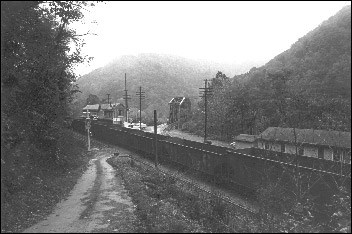
(Photo by R. Eugene Harper, National Park Service)
This lesson is part of the National Park Service’s Teaching with Historic Places (TwHP) program.
Deep in the coal fields of West Virginia, the rumble of a steam locomotive mingles with the sound of the New River crashing through its steep rocky gorge. With brakes squealing, the train passes a signal and slows for its approach into the town of Thurmond. The hulking locomotive comes to a stop in front of the train depot as the track supervisor checks the traffic. Simultaneously, the conductor announces the train and workers remove bags of mail and parcels from the baggage car. Arriving passengers get off the train, while those departing stream from the station’s crowded waiting room to take their seats.
Yard workers quickly uncouple the engine, and the engineer takes it to the coaling and water towers to refuel. As the locomotive is re-coupled to the cars, the conductor nods to the engineer and announces the train’s departure. The steam engine sends an explosive puff of smoke upwards, and the deafening whistle blows. As the sound of the train fades to a rumble, a fine dusting of soot settles on the starched white shirts and fashionable hats of the men and women bustling along the crowded sidewalk. From a distance they hear the approaching sound of yet another train coming into the town of Thurmond.
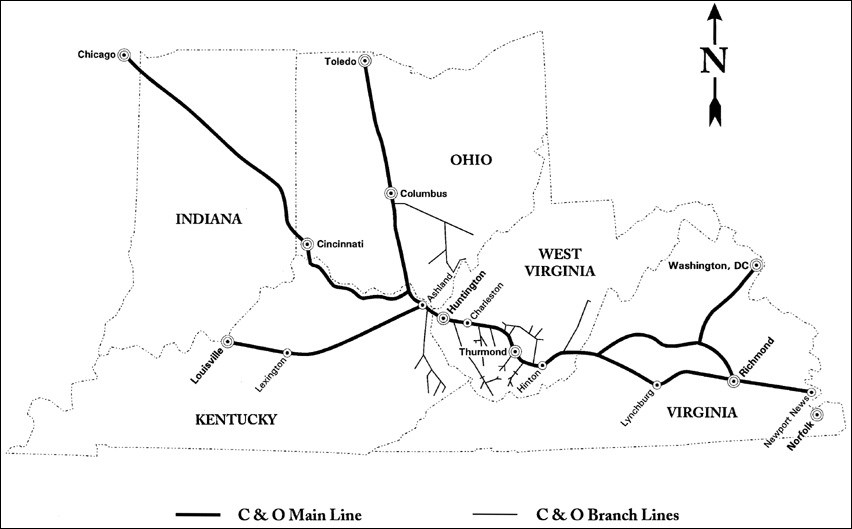
Map 2: The coal mine connection.
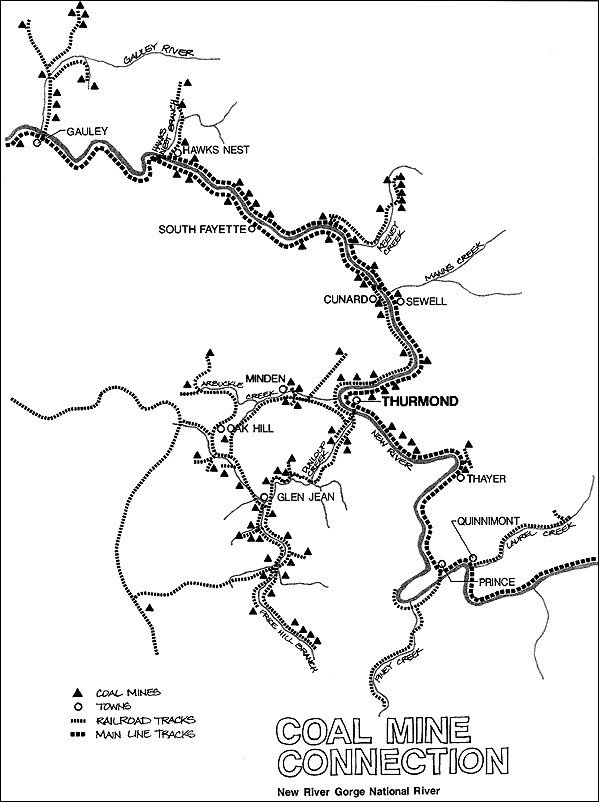
Questions for Maps 1 & 2
1. Locate Thurmond on both Maps 1 and 2. Compare the main geographic features of the gorge with the rail line locations on Map 2. What are the similarities?
2. Count the number of coal mines in the area on Map 2. How many of these mines connect with Thurmond by a railway along a minor waterway?
Determining the Facts
Reading 1: A Railroad Town
Thurmond, West Virginia, was amazingly busy, considering its location in a deep gorge. For 35 years the town could only be reached by train. As the chief railroad center on the C&O Railway, Thurmond served major portions of the mountainous coal fields of southern West Virginia. These coal fields produced more tonnage of coal and more freight revenue than the major national shipping centers of Cincinnati, Ohio, and Richmond, Virginia, combined. In 1910 four million tons of coal were shipped from Thurmond, producing $4,824,911 in freight revenues. The town had no streets or cars until 1921, but did have homes, banks, hotels, and a thriving commercial district.
Thurmond is named for William Dabney Thurmond, who received the 73-acre site in 1873 as payment for a surveying job. That same year, the C&O Railway opened its main line from the Atlantic coast to the Ohio River. Ten years later, a freight station was built at Thurmond, and soon after, a railroad bridge was completed to connect the coal mines across New River with the main line. Land adjacent to Thurmond became an assembly yard for transportation operations in the gorge. As more spur lines reached outlying coal mines, the site grew into a town to meet the needs of the coal companies and their workers.
Geography has greatly influenced the layout of Thurmond. It is located in the middle of the New River Gorge, a steep, 80-mile-long valley cut by the New River. The floodplain--a narrow, flat strip of land--was broad enough at Thurmond for a railroad assembly yard, but the town had to be built up the towering steep slope behind. No street lies between the tracks and the commercial buildings facing the river. The rocky mountain behind Thurmond rises more than 700 feet above the river.
The first Thurmond passenger station burned in 1899. The depot was rebuilt in 1904 and still stands today. A sloped roof extends from the first story and partially shelters the station platform. An extended portion of the upper story has eight windows and serves as an observation and signal tower. The ground floor held a baggage room, Railway Express (delivery service), lunch and news counter, ticket agent booth, waiting rooms and rest rooms. The second floor was divided into offices for the yard master, conductors, train operator (in the signal tower), track supervisor, car distributor, chief clerk, train master, and coal buyer. In order to keep the steam engines and their cars moving 24 hours a day, these positions had to be manned around the clock.
During its heyday, 150 to 200 men worked for the rail operations at Thurmond, keeping coal supplied to the growing industries of the nation. Coal from southern West Virginia heated cities, forged steel, and powered the steam engines of ships, trains and factories. Just as the railroad shipped coal out of the gorge to the rest of the nation, it also brought goods from the outside world into Thurmond. The Hudson Wholesale Fruit and Produce Company received carload shipments several times a week and made daily deliveries to area stores. The Armour Company distribution center shipped wholesale meats up and down the rail line. An orchestra came from Cincinnati to play at the opening of a new hotel across the river. The train also brought traveling men, businessmen, gamblers, adventurers, and soon-to-be brides to the town. For New River miners seeking escape from a drab coal town, Thurmond was a short train ride away. According to local resident Herman Monk, "The sidewalk looked like Broadway there on a Saturday night."¹
Questions for Reading 1
1. What was the town’s main industry?
2. Would you consider Thurmond to have been well located? Justify your answer.
3. Who used the Thurmond train depot, and how did they use it?
4. If the town of Thurmond had not been established, do you think the lives of the people of that area would have been richer? poorer? Why?
5. If the railroad employees of Thurmond had not performed their jobs properly, how would it have affected people living on the Atlantic coast? the rest of the nation? Justify your answer.
Reading 1 was compiled and adapted from R. Eugene Harper, "Thurmond Historic District" (Fayette County, West Virginia) National Register of Historic Places Registration Form, Washington, D.C.: U.S. Department of the Interior, National Park Service, 1983; and Ken Sullivan, Thurmond, A New River Community (Fort Washington, Pa.: Eastern National, 1989).
¹Ken Sullivan, Thurmond, A New River Community (Fort Washington, Pa.: Eastern National, 1989), 31.
Determining the Facts
Reading 2: Behind the Scenes
This reading includes brief descriptions of some of the most important jobs performed at the depot around 1910. Operations required the depot to stay open 24 hours a day.
Yard Master: The yard master managed rail operations. He located empty and full freight cars along the railroad through the telegraph operator and arranged for them to be picked up and sent to new destinations. He called for yard crews and kept main line tracks clear for incoming trains. He made a train list of freight cars and their destinations for the yard conductor.
Yard Conductor: The yard conductor received train lists from the yard master and ordered yard crews to find each car and assemble the train into station order, which meant that at each stop on the run, cars for that point were in the correct sequence to be disconnected. The yard master gave a copy of the train list to the engineer.
Well, you’re in charge of the whole train....And if anything goes wrong, why, they want to talk to the conductor....if anything happened to the train, if you derailed, they want to know where it’s at; they want to know how many cars is involved in it. Well, they can’t nobody else tell that but the conductor.¹
Call Boy: When the yard master had need of an off-duty yard crew, he would give the job of finding them to the call boy, who would run off to round up the men.
The only man that could go into a saloon [during his working hours] without getting fired was the call boy. He could go in and come out. They didn’t pay no attention to that, you know, because that was where he had to go most of the time to find the man, you know, when he was out lookin’ for him to go out on the run.²
Car Distributor: The area mines would call the car distributor to request that empty cars be dropped off and loaded cars removed. He had a clerk list this information and pass it on to the yard master.
Telegraph Operator/Signal Operator: A telegrapher could quickly send and receive information through wires by Morse code. Women and men telegraph operators communicated with other operators up and down the line to relay information vital for a safe, efficient transportation operation. The telegrapher relayed or received orders to switch tracks if necessary, or to slow or stop trains. The telegrapher would post a signal for the incoming engineer and throw the track switches.
Chief Clerk: Several clerks, both men and women, completed paperwork. Often this position gave new employees their start. A clerk’s time would be divided among the offices: working four hours for the track supervisor, writing letters and taking dictation; then four hours for the train master, keeping records and inspecting schedules and bulletin books; then another four hours with the car distributor preparing car lists. The chief clerk would relay vital schedule information to the yard master.
I had written the C&O Railroad superintendent here in Hinton, telling him that I had finished high school and I had taken shorthand and could use a typewriter, and if a job should come open, I would be glad if he would give me consideration for it...it was Christmas Eve and I got a phone call...that a job was awaiting me.³
Questions for Reading 2
1. Which job do you think you would like to have had? Why?
2. Which jobs do you think carried the most responsibility? received the highest pay? the least pay?
3. How many hours per day did the clerk work?
4. What do you think the yard master would have done if his relief shift did not show up for work?
Reading 2 was compiled from Chesapeake & Ohio Railway Company Schedule of Wages and General Regulations for Conductors, Trainmen, and Yardmen, C&O Railway, 1927; and Michael W. Caplinger and John T. Hriblan, "Thurmond Passenger Depot and Offices," Historic Furnishings Report, the Institute for the History of Technology and Industrial Archaeology, West Virginia University, 1993.
¹Robert Carter, National Park Service oral history interview, November 15, 1983. Interview conducted by Jim Worsham.
²Carter.
³Ray E. Sawyer, National Park Service oral history interview, September 10, 1983. Interview conducted by Jim Worsham.
Determining the Facts
Reading 3: A Ballad
West Virginians have a rich cultural tradition of folk music and have produced many ballads about train disasters. Train lore reflects the whole country’s romance with progress and speed. Songs about brave railway men highlight the importance of railroads in our nation’s development and identity.
THE WRECK OF THE SPORTSMAN
Far away on the banks of New River
While the deep shades of twilight hung low,
In the mountains of old West Virginia,
On the line of the old C & O;
Down the valley the old Forty-Seven
Was winding her way ’long the stream.
The drivers were rapidly pounding
While the engine was trembling with steam.
Haskell firmly held the throttle,
Anderson’s fire glowed with red,
And they thought of no danger awaiting
Down the line on a curve just ahead.
In the dusk of a fair crimson sunset
Near the path of the old Midland Trail,
'Twas there that the fast-flying Sportsman
Was wrecked as she swung from the rail.
'Twas there in the dark shades of twilight,
While the bright crimson sky was aglow,
That Haskell and Anderson of the Sportsman
Gave their lives to the old C & O.
Just west of the station called Hawk’s Nest
The engine turned over the fill;
The boys were found down near the river
By the engine they loved, lying still.
That night there were loved ones waiting
In Huntington for those boys--in vain,
For God, the Supreme Crew Caller,
Had called them for another train.
The years full of tears may be many,
And sad broken hearts ever burn,
While they think of the "Wreck of the Sportsman,"
And the loved ones who’ll never return.
Questions for Reading 3
1. Describe the setting or background of the ballad. How does that relate to the action described?
2. What is said about the character of the railway men? Were they hardworking? dedicated? reckless? skilled?
3. Are the men described in the ballad heroes? Why or why not? Why does the ballad emphasize how much the men loved their work?
4. Are steam train engineers still recognized as major figures in our history? Are they part of our national identity? Why or why not?
Reading 3 was excerpted from SCALDED TO DEATH BY THE STEAM by Katie Letcher Lyle. Copyright © 1991 by the author. Reprinted by permission of Algonquin Books of Chapel Hill, a division of Workman Publishing.
Visual Evidence
Photo 1: Thurmond, West Virginia, c. 1920.
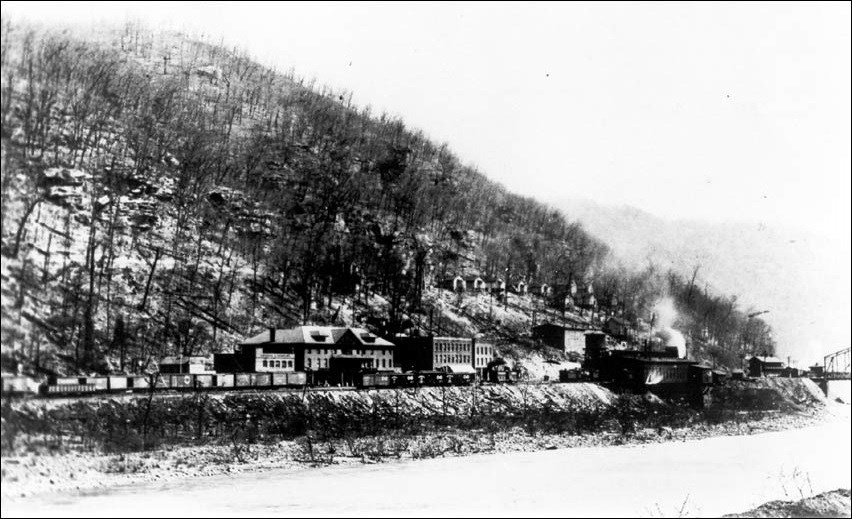
Questions for Photo 1
1. Examine Photo 1. What geographic features are immediately noticeable?
2. Can you identify where you think the train depot and the engine repair house might be? Which buildings would most likely be employee housing?
Visual Evidence
Illustration 1: Layout of Thurmond.
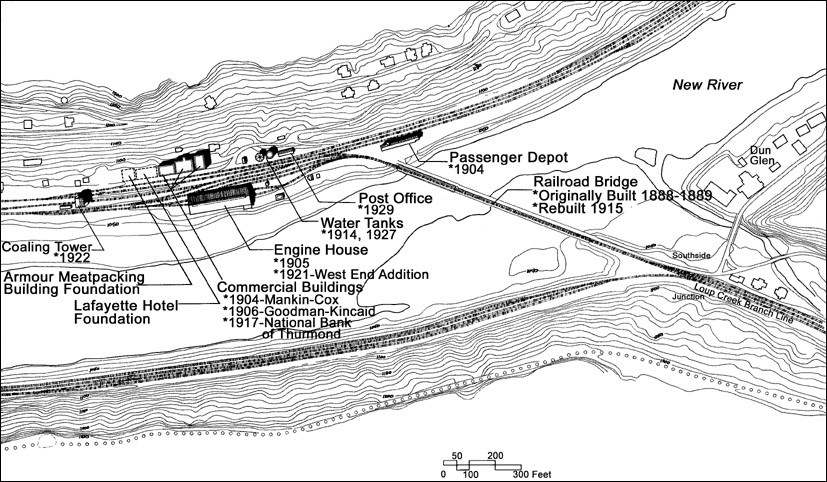
Photo 2: A postcard picture of Thurmond depot, photographer and date unknown.
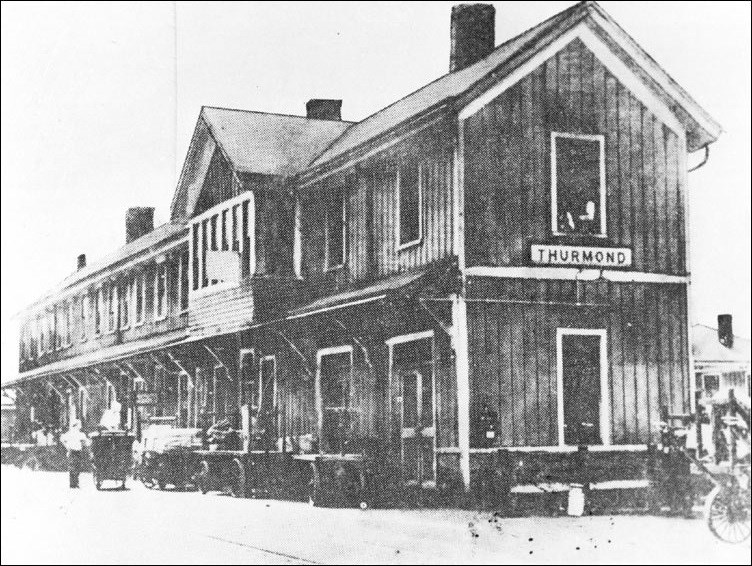
(New River Gorge National River)
The Thurmond train depot shown on Illustration 1 and and in Photo 2 is approximately 152 feet long and 16 feet wide at the base. It is situated along a set of three tracks.
Questions for Illustration 1 & Photo 2
1. Study Illustration 1 and Photo 2. Do you think the town’s geography influenced the depot’s architecture?
2. Note the topographic increments on Illustration 1. The elevation gets progressively higher further away from the depot and railway area. Using the scale, calculate the approximate distance in feet from the depot to the rail workers’ homes (located above the depot). Why do you think the workers built their homes so far above the tracks? (Students may want to refer to Photo 1.)
3. The signal operator worked on the second floor of the Thurmond depot and coordinated the signals used to tell train engineers to slow down or stop. Examine Photo 2 and locate the windows in the overhanging office. Why was the depot designed with a section extending further out than the rest of the building?
Visual Evidence
Photo 3: Ticket office at a C&O depot in Pratt, West Virginia, 1925.
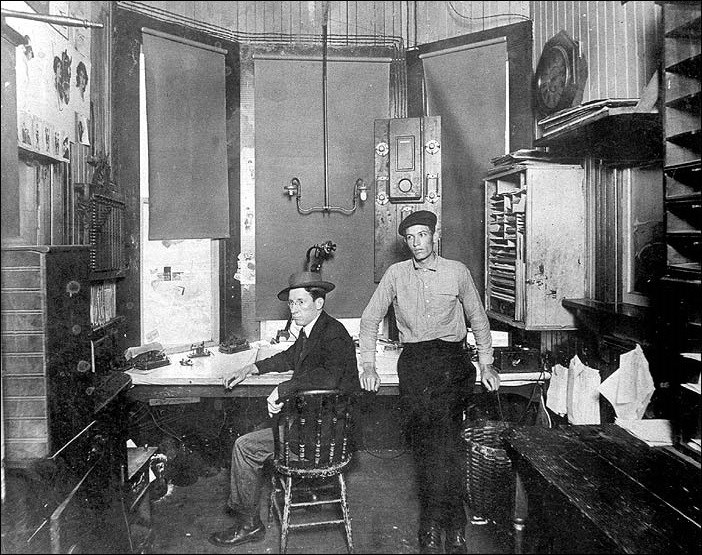
Questions for Photo 3
1. Look closely at Photo 3, a typical ticket office. What equipment that is no longer used today is visible in this office?
2. Is it possible to determine what work is being done? Do you think that work would be very different from what is done in a modern railroad office? Why or why not?
Putting It All Together
Thurmond enriched the communities it served and made important contributions to the nation's economy and identity. Through the following activities, students will experience the responsibilities of rail workers in the early 20th century, explore the role of transportation workers today, and use imagery to honor those who have served our country in the transportation field.
Activity 1: Role Play
In 1911 Thurmond handled 71,546 passengers and 3,697,277 tons of freight. Rail workers’ experiences indicate how complex and dangerous daily rail operations could be. Have the class look again at Readings 1 and 2. Then divide the students into groups of five or six. Cut copies of Reading 2 into separate job descriptions. Each group of students should have one copy of each job description and each student should take a role. For groups of five eliminate the position of the call boy. Read the following sequence of scenarios to the class, and ask each group to consider what actions might occur as a result of each one. Then ask each group to role play that action according to their assigned roles. In parentheses following each scenario is a possible response to the situation that the students might act out.
Scenario A: Several requests are telegraphed to the train depot for pickup of full coal cars and drop-off of empty cars. (Telegrapher may relay information to car distributor, who may relay it to chief clerk, who may prepare a list of available cars and pass it to yard master, who may give the list to the yard conductor, ask the telegrapher to contact other stations for empties, and call for a yard crew.)
Scenario B: A special excursion train is bound for a resort town. This is not a regularly scheduled train. It is due to come through Thurmond at 2 p.m. using the main line track nearest to the rail yard. (Chief clerk may tell the yard master who would check schedules and make sure the line is clear, and would warn engineers who might be using the line; yard master would keep the yard conductor aware of the change in the normal schedule.)
Scenario C: It is very difficult to assemble freight cars in the long, narrow rail yard without using one of the main line tracks. This causes a safety hazard, but the cars must be assembled and leave the station by 2:30 p.m. (Yard master may or may not decide to use the main line track. Yard master may ask the telegrapher to signal incoming trains to slow, stop, or switch to another track. Telegraph operator may signal the excursion train to use another track, throw the track switch, or request another station on the line to signal and switch tracks.)
Now tell the students to assume that it is 1:55 p.m. and they need to answer the following questions and discuss the results of this activity:
1. Does the yard crew have any cars on the main line track?
2. Who knows about the excursion train? How did they find out?
3. Will the freight cars be assembled in appropriate order in time to depart at 2:30 p.m.?
4. Will the excursion train rumble through Thurmond safely on its way east, or will it meet with disaster?
Conclude the activity by having students discuss the complexity of running a train yard that was busy 24 hours a day.
Activity 2: Recognizing Others
Ballads about railroad disasters memorialize the people and the events in a specific style. Ask students to identify examples of characteristic elements of the ballad found in Reading 3--rhyming, repeated phrases, focus on specific individuals, emphasis on speed, foreshadowing, colorful descriptions, and ending with lessons or warnings for others.
Then have the students research a recent transportation disaster such as the Exxon oil spill at Valdez, Alaska, or the plane explosion over Lockerbie, Scotland, gathering information about the people involved if possible. Ask the students to write a ballad about the calamity they researched, using the typical railroad-disaster style. Remind the class that through ballads, writers can commemorate important events, help victims deal with tragedy, and honor the contributions of others. Read several of the completed ballads to the class or ask students to recite or sing their ballads. Then have a general classroom discussion in which students discuss the appropriateness of using ballads to memorialize the role of a particular hero. What other ways can such people be recognized (epic poems, eulogies, inscriptions on tombstones)?
Activity 3: Transportation Then and Now
Remind students that transportation workers of all kinds have contributed to the development of the nation by serving their communities. Have small groups of students contact and interview transportation workers in major transportation centers nearest their community (airport, bus station, ferry port, railroad freight yard or depot, etc.).
Then have each group prepare a class presentation which addresses the following:
1. Identify and describe the center of transportation they investigated.
2. Describe its similarities and dissimilarities to Thurmond.
3. Describe the duties and equipment of the transportation workers they interviewed.
4. Compare those job duties and the equipment used with the jobs and equipment of the rail workers of Thurmond in 1910.
5. Compare the length of workday, levels of responsibility, required education, and safety and danger in the transportation system today and in the past.
Thurmond: A Town Born from Coal Mines and Railroads--
Supplementary Resources
By looking at Thurmond: A Town Born from Coal Mines and Railroads, students will examine the complex and often dangerous daily routines at the Thurmond train depot, and learn how rail workers were immortalized by some of the people they served. Those interested in learning more will find that the Internet offers a variety of interesting materials.
New River Gorge National Park
New River Gorge National Park is a unit of the National Park System. This unit of the National Park System encompasses over 70,000 acres of land along the New River between the towns of Hinton and Fayetteville. Visit the park's web pages for more information on the history and recreational activities at this park which includes Thurmond Historic District.
Smithsonian Institution: National Museum of American History
Visit the Smithsonian's on-line America on the Move exhibit explores transportation history in the U.S. including the history of the development of rail commerce in the Industrial Age.
Library of Congress
American Railway Maps, 1828-1900
View the American Memory Collection of Railway Maps by searching with keywords or browsing by geographical location. Check out the sections titled "History of Railroads and Maps," "Related Resources," and "Learn More About It!"
Built in America: Historic American Buildings Survey/Historic American Engineering Record (HABS/HAER)
Search the HABS/HAER collection using keywords such as Thurmond, West Virginia to discover resources such historical photographs, data and architectural drawings on the various structures related to Thurmond's railroad industry.
Chesapeake & Ohio Historical Society
The Chesapeake & Ohio Historical Society provides extensive information on this historic railroad. An interesting project of the Society revolves around the old C & O passenger cars. They have gathered photographs, engineering records and historical accounts of some of the remaining cars and are in the process of restoring them.
